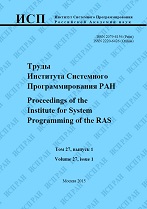|
This article is cited in 1 scientific paper (total in 1 paper)
Numerical study of characteristic modes and frequencies of flow in high-speed compressors
M. Kalugina, I. Evdokimovb
a Institute for System Programming of RAS
b AVIATICA Ltd
Abstract:
In this paper, we present the newly developed open-source density-based solver pisoCentralDyMFoam and investigate an application of the Proper Orthogonal Decomposition (POD) algorithms for industrial turbomachinery-related problems. POD is implemented in Apache Spark framework for distributed data processing. This solver is based on hybrid Kurganov-Tadmore/PISO scheme. The research was conducted for geometry close to its real prototype with known resonance frequencies. The solver was previously validated on simple industrial case ERCOFTAC centrifugal pump. The POD coefficient matrices were constructed using data set of the snapshots representing each saved time-step of the whole Navier-Stokes numerical model. Several hundred consecutive snapshots of the static pressure field on the impeller wheel surface as well as the velocity field were used for computation of the POD modes. The eigenvalues determined by POD method corresponds to the kinetic energy contained in each mode. The spatial coefficients represents contribution of each elementary volume to the whole mode and helps to locate the region having influence on the mean flow at specific frequencies after Fast-Fourier-Transform (FFT) applied to time-dependent coefficients of the decomposition. The POD modes were sorted by kinetic energy and the zeroth mode was most energetic representing mean flow with relatively small amplitudes. The described concept was extensively validated using computationally cheap 2D-case and then extended to the high-speed centrifugal pump of the small-scale turbojet. It was found that the third mode of the flow has first peak at 12970 Hz right between 2 construction resonance points at 12000 Hz and 13700 Hz. The third and fourth modes represent pressure fluctuations in the wakes region in the diffuser behind vanes. The demonstrated approach allows engineers to analyze flow dynamics more effectively compare to traditional FFT at certain points or cross-section. In addition, it can be useful for data compression and Reduced-Order Model development.
Keywords:
proper orthogonal decomposition, centrifugal pump, fluid dynamics.
Citation:
M. Kalugin, I. Evdokimov, “Numerical study of characteristic modes and frequencies of flow in high-speed compressors”, Proceedings of ISP RAS, 29:1 (2017), 21–38
Linking options:
https://www.mathnet.ru/eng/tisp98 https://www.mathnet.ru/eng/tisp/v29/i1/p21
|

| Statistics & downloads: |
| Abstract page: | 144 | | Full-text PDF : | 110 | | References: | 40 |
|




 Contact us:
Contact us: Terms of Use
Terms of Use
 Registration to the website
Registration to the website Logotypes
Logotypes








 Citation in format
Citation in format 
